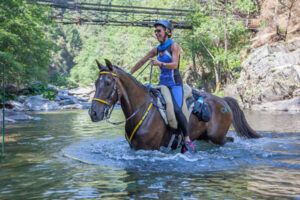
Two years ago, Kathy Edman of Florence attempted to complete the Tevis Cup race, a grueling 100-mile horse race that must be completed in 24 hours, not one minute passed the 24-hour mark. The race, formally known as the Western States Trail Ride, begins in Lake Tahoe at Robie Park. The trail winds through the Sierra Nevada mountain range. The route follows Forest Service roads, and trails that a mountain goat would have reservations about. It is said there are about 17,000 feet of climbs and almost 22,000 feet of drop throughout the course.
On her trek in 2012, Edman and her Kentucky Mountain Horse, Pierce, made it 85 miles before she was pulled at a vet check. The safety of the horse in a race like this is of utmost importance. The horses are checked by veterinarians at specific points throughout the race. They are checked for signs of stress, lameness and of course their heart rate and rate of recovery. There are two mandatory ‘holds’ where the horse and rider must remain for 60 minutes. Even after crossing the finish line, the horse is checked on final time and if he doesn’t meet the criteria, the buckle for finishing is not awarded.
Edman knew all of this and she knew that she has a distinct disadvantage with her horse. Almost all endurance horses are at least part Arabian if not full blood Arabian. The breed is used because of its naturally lower heart rate and ability to quickly recover. Edman’s horse, the Kentucky Mountain Horse Pierce, is not considered to be an endurance horse. Edman was aware of this during her training for the first race and felt that although she made the adjustments for Pierce’s heart rate and recovery time, she could do better.
“I knew I had to come back (to the Tevis Cup) and finish,” said Edman. “I just didn’t know who I would be on.”
Edman and Pierce didn’t take a lot of time off after competing at Tevis in 2012. They were back out on the trails, conditioning and working hard by spring of 2013. Edman competed in a couple shorter (50 mile rides) and by last fall, she knew they were ready to get serious about Tevis again.
“This horse is amazing,” said Edman. “His heart and desire just keeps me going.”
With the 2014 Tevis Cup in mind, and knowing what to expect this time, Edman set about training; not only her horse but herself as well. She also knew that the heart rate standards for this year’s race had been lowered even more so she was going to have to really work to have Pierce where he needed to be prior to the race and then during the race.
Personally, she became much more conscious about what she was eating and lost 12 pounds. She ran because she knew she was going to have to get off and run while leading Pierce prior to every vet check. (It helps to lower the heart rate.) Edman ran the half marathon (13 miles) at Missoula just three weeks prior to the endurance race.
Because the race is held over a mountain range, a lot of training is done climbing hills and mountains. But because Pierce is naturally a bit bigger and has big hindquarters, she opted not to do a lot of heavy climbing with him. She wanted long, lean muscles that weren’t as apt to cramp as the race went on. She changed his diet as well, using different electrolytes (served in applesauce).
All of these changes were not just the result of Edman’s deductions but also of her ‘crew’. Dr. Tom Currier of Ambrose Vet Clinic, Drin and Jim Becker of Polaris, and her daughter Bethany all played crucial roles in Edman’s success. Currier and Edman worked on Pierce throughout the summer on diet and training, and then Currier was there for the race as well. He is a seasoned endurance rider as well as a veterinarian and understood what was needed to get Pierce to where he needed to be. Drin Becker competed in 2012 and finished, earning the coveted belt buckle. She and her husband Jim handled the logistics of getting the crew from point A, Lake Tahoe, to Auburn, while helping out with the horse and the rider. While Currier and Becker were taking care of Pierce at the vet checks, Bethany was taking care of her mom.
Edman said that learning to depend on her crew was probably the biggest obstacle she had to overcome. After almost too strong of a start where it was all she could do to slow Pierce down, and going in and out of three canyons during the heat of the day with out any crew members to meet her at the vet check, she and Pierce were wearing down.
“Pierce hit the wall and started overheating. It took a lot out of me to get him cooled down.” Currier was there at the next vet check and told her it was time for her to go to work and ‘run down some of the hills, while leading Pierce.’ “This was where the marathon training paid off.”
The last part of the race was the best for her even though it was in the middle of the night. (The Tevis Cup is generally set so that the race falls during the full moon.) At the finish line, 23 ½ hours after she began, Edman was so excited her crew had to get after her to get off the horse and cool him down before the final vet check.
Edman relied a lot upon her faith during the race. “God is always sending me something. I’m thankful he speaks ‘horse’ to me. I had always thought the crew was a luxury and that I could do it myself. They gave me the strength to finish.”